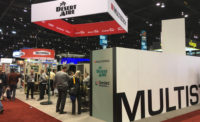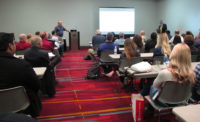Marijuana grow facilities are providing a new market for contractors and manufacturers as 29 states currently have laws legalizing marijuana for medicinal purposes with an additional eight permitting recreational use of cannabis, including Washington, District of Columbia.
Desert Aire, a Milwaukee-based manufacturer of commercial and industrial dehumidification and indoor climate control systems, is one of the companies entering this market.
The NEWS recently talked with Keith Coursin, president of Desert Aire, who had recently returned from the Marijuana Business Conference & Expo in Washington, District of Columbia. In addition to his duties at Desert Aire, Coursin served in 2009 as chairman of the board of directors of the Air-Conditioning, Heating, and Refrigeration Institute (AHRI).
The NEWS: Keith, you were just at the Marijuana Business Conference & Expo in Washington, D.C.? Were you there for business or pleasure? I kid, I kid.
Coursin: Working is always a pleasure. Walking and talking with this very diverse industry — growers, processors, and retail — you see a lot of different people who just want to talk about it. It’s a very upbeat conversation where people see this great opportunity, and they want to belong. It’s really a diverse population in this industry.
The NEWS: How did Desert Aire get involved in this market?
Coursin: It was really our current customers of mechanical engineers and mechanical contractors who would call and say they need help in selecting and sizing a piece of equipment to take care of this moisture problem. What really hit me early on was how close this application was to one of our core markets — the indoor pool segment. I have used that as part of my explanation to people I’m talking with who don’t understand HVAC. We have solved problems in indoor pools where there is water always giving up moisture. In an indoor grow facility, the plants and water are always giving up moisture. We are talking about design conditions that are very similar — hot and humid, 80°F, and 50-60 percent relative humidity. There are similarities. Pool rooms need heat in the wintertime and cooling in the summertime. Our dehumidifier is a heater, air conditioner, and dehumidifier. In our industry, we just call them dehumidifiers, but they do the complete range of air-handler tasks for an indoor pool. Come into the indoor grow room; when the lights are on, you have to cool, and when the lights are off, you need to heat. Our customers actually recognized it before we did. This was the same range of tasks and the same problem to solve. That is how we got going in this marketplace.
The NEWS: Were you getting requests from all over the country or one specific place? Obviously Colorado is the first place that comes to mind.
Coursin: It followed the legalization of the products through the states. But we heard it from two sides. It is not just cannabis; it is indoor growing. You look at your vegetables and leafy greens and strawberries; there is a movement going on where people want their produce fresher, ripened on the vine, and without chemicals. How are you going to do that if you are bringing them in from Chile? They are not ripened on the vine; they are ripened on the boat. So, those indoor grow facilities, just like cannabis facilities, the metric they are talking about is how much production per acre are you getting on indoor grows versus outdoor, given your inputs and resources. In California, a head of lettuce takes 30 gallons of water to produce. In an indoor grow room it takes three-tenths of a gallon. Now you start looking at water as a resource and meeting the local delivery requirements of consumers. As a general grouping, indoor grow rooms are really starting to come into their own. It is controlling the entire environment. Bold markets exist.
The NEWS: I assume some companies would not want to be involved strictly from the public relations side. Was that an issue for you guys?
Coursin: It was a major discussion. We brought it up to the board level, and we presented what we saw as a market opportunity. As we developed what we thought the opportunity was, the board said our mission statement is to maintain a healthy and clean environment for our markets, so it fit what we do perfectly. We then talked about the ramifications of the issue in regards to legality, personal preferences, etc. We had a good discussion, and the conclusion we all had was that it is deemed legal in those states; therefore, we are going to treat it as a legal enterprise and move forward. We are willing to put a cannabis leaf on a brochure and say this is a business we are in. If you don’t like it, that’s OK, but we are here to support the growers of all types of cannabis and other food products.
The NEWS: Do you believe this is going to continue to evolve? Do you ever see it going back?
Coursin: It is moving fast. I think we are at the tipping point. Over half the states have legalized medical marijuana, and many more are considering recreational legalization. As was the commentary at the conference, what is the federal government going to do? There still is no buy-in from the federal government. Until they say they will accept it and shift it to legal, and until the banking system can do their thing under a normalized banner, there is a chance this could all end tomorrow. If you look at what Canada is doing, they went on the federal basis on the medical side, and they are now moving forward on the recreational side. They can borrow money. Public companies can have it as part of their portfolios. Everything is being managed in a very traditional business way that is generating a lot of tax revenue. I think the discussion has to be had at the federal congressional level. Until that happens, there is a black cloud hanging over the industry.
The NEWS: What was the reaction to your product at the event?
Coursin: We got what we wanted out of the trip. People have told us that we really know what is going on in their environments, and they don’t get that from others. That is because we have done the research. Some of the growers and horticulturists like the idea they are talking to someone who understands their problems.
The NEWS: How about the HVAC industry in general. What are you seeing out there?
Coursin: We are seeing a very active marketplace on both the design and construction side in a multitude of market segments, which is really nice. I think K-12 is lagging a little bit, but we see a very robust industry. We experienced a growth factor last year, and that is continuing this year. Labor is the issue. It takes a lot of effort to get people. The limit on most of our businesses is talent.
Publication date: 8/21/2017
Want more HVAC industry news and information? Join The NEWS on Facebook, Twitter, and LinkedIn today!






Report Abusive Comment